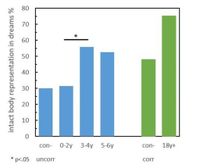A recent study published on March 22, 2025, unveils fascinating insights into the dream content of individuals with congenital amputations and those who lost limbs early in life. Researchers observed that congenital amputees, who often lack experiences of an intact body, report significantly fewer dreams featuring an intact body representation compared to their counterparts who experienced limb loss after birth. This cross-sectional study, involving 182 participants, sought to investigate how the age at which an arm or leg is lost affects the recollection of bodily identity in dreams.
The study found that participants with congenital amputations reported a mere 30% recall of intact body representations within their dreams. In contrast, amputees who lost their limbs at ages between 0-6 exhibited a rising trend, with a 50% recall reported among those who lost limbs closer to the age of 3. Researchers suggest that the age at amputation plays a critical role in shaping the internal body model, which is reflected in self-related content in dreams.
This groundbreaking research indicates that individuals who were amputated before the age of three might not explicitly recall themselves as intact, as early-life experiences significantly influence dream content. In essence, the researchers posit that the continuity hypothesis of dreaming is upheld; the experiences of waking life tend to filter into after-hours consciousness, albeit in nuanced ways particularly for those with congenital disabilities.
The study, led by a team of researchers from esteemed institutions, involved a cross-sectional analysis of adult congenital amputees compared to those who underwent limb loss at various stages of early childhood. Key findings suggest that recalling a body as intact in dreams may significantly hinge on prior lived experiences of having an intact body. In accordance with the statistical analysis conducted, the age of amputation was predicated to be a strong indicator; those suffering amputation at an older age had a 1.460 chances higher of recalling intact versions of themselves in dream scenarios.
Notably, when the study assessed the potential impacts of phantom limb pain (PLP), results indicated that PLP did not have a significant effect on dream content representation compared to age at amputation. This absence of correlation urges a reevaluation of the understandings surrounding the associations between physical sensations and psychological experiences within the context of dream recall.
This investigation sheds light on the critical developmental period around ages 2 to 3, where individuals begin to form robust memories of their bodily selves, potentially leading to long-lasting implications for understanding identity formation in individuals living with congenital limb absence. With this new understanding, it compels further explorations aimed at assessing how subconscious representations impact daily life for those who navigate the world with profound body experiences such as congenital amputees.
In conclusion, these findings underscore the importance of internal body representations in shaping personal identities and waking lives. Given the vulnerability of young children to trauma before proper etching of personal narratives, researchers assert a necessity for deeper exploration of the interplay between bodily integrity, dream content, and subjective identity perception. Further studies may yield revelations about coping mechanisms employed by amputees and broader considerations for mental health integration in clinical practices tailored for similar conditions.

